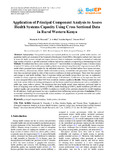| dc.contributor.author | Wanzala, Maximila N. | |
| dc.contributor.author | Oloo, J. A | |
| dc.contributor.author | Nguka, Gordon | |
| dc.contributor.author | Were, Vincent | |
| dc.date.accessioned | 2024-01-10T09:42:22Z | |
| dc.date.available | 2024-01-10T09:42:22Z | |
| dc.date.issued | 2019-01-05 | |
| dc.identifier.uri | https://doi.org/10.12691/ajphr-7-1-5 | |
| dc.identifier.uri | http://article.scipublichealthresearch.com/pdf/AJPHR-7-1-5.pdf | |
| dc.identifier.uri | http://ir-library.mmust.ac.ke:8080/xmlui/handle/123456789/2507 | |
| dc.description.abstract | Introduction: Strong health systems are essential platforms for accessible, quality health services, and
population health and attainment of the Sustainable Development Goal (SDGs). Descriptive methods have been used
to assess the health systems strength and impact, however, there is inadequate knowledge on methods of analyzing
huge number of indices to provide systematic evidence that service readiness is improving or deteriorating over time.
Methods: We utilized data from a cross section survey of 71 health facilities in Kakamega County of western Kenya.
A total of 151 indices of the health system building blocks were reduced using Principal Component Analysis (PCA)
model which generated factor weights for the individual indicators. These included indices from human resources,
service delivery, infrastructure, finance, health information systems, commodities and governance. Factors weights
were then summed and ranked in order of their relative contribution to better performance. These were then summed
and average to rank health facilities. Sum of indicators within each health system block was used as explanatory
variables in a linear regression model with overall average of all indicators. Coefficients of the regression was used
to assess marginal effects and p-value<0.05 were considered statistics significant. Results: The top ranked indicators
were basic service deliver for testing and diagnosis and the lowest ranked were infrastructure such as availability of
public taps, water, toilet or privacy. The department that were highly ranked whose indicators performed better in
terms of weighting, were service delivery (p<0.0001), health financing (p<0.0001), health workforce (p=0.005) and
medical supplies and commodities (p<0.0001) in relation to overall service provision denoted by overall weighting
for all indicators. Health governance was not a significant factor influencing service provision. Conclusion: PCA is
an essential methodology for assessing health system readiness and preparedness to provide accessible and quality
service delivery in resource poor settings. | en_US |
| dc.language.iso | en | en_US |
| dc.publisher | American Journal of Public Health Research | en_US |
| dc.subject | Application , Principal, Component, Analysis,Assess, Health, Systems, Capacity, Cross, Sectional,Data, Rural, Western | en_US |
| dc.title | Application of Principal Component Analysis to Assess Health Systems Capacity Using Cross Sectional Data in Rural Western Kenya | en_US |
| dc.type | Article | en_US |

